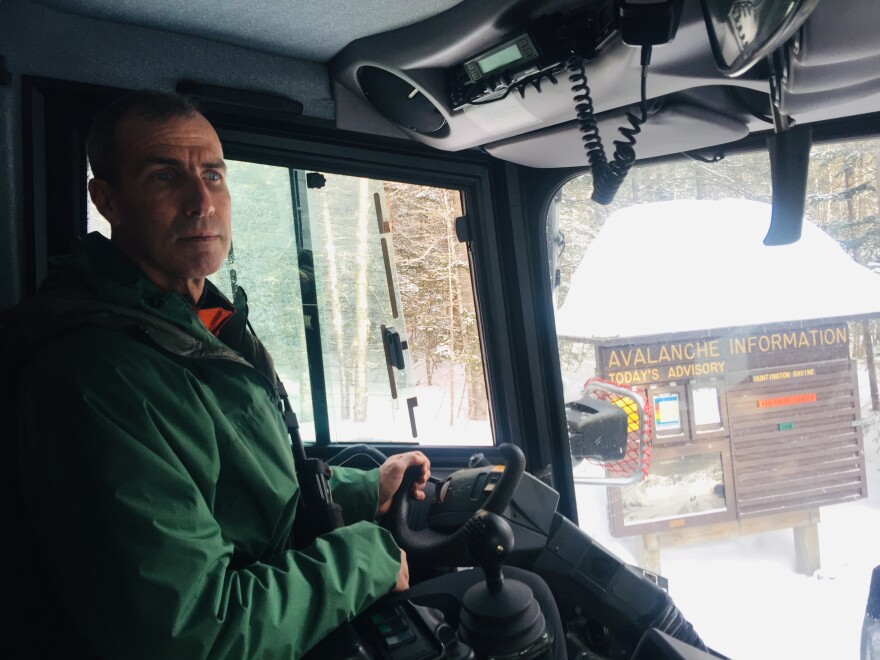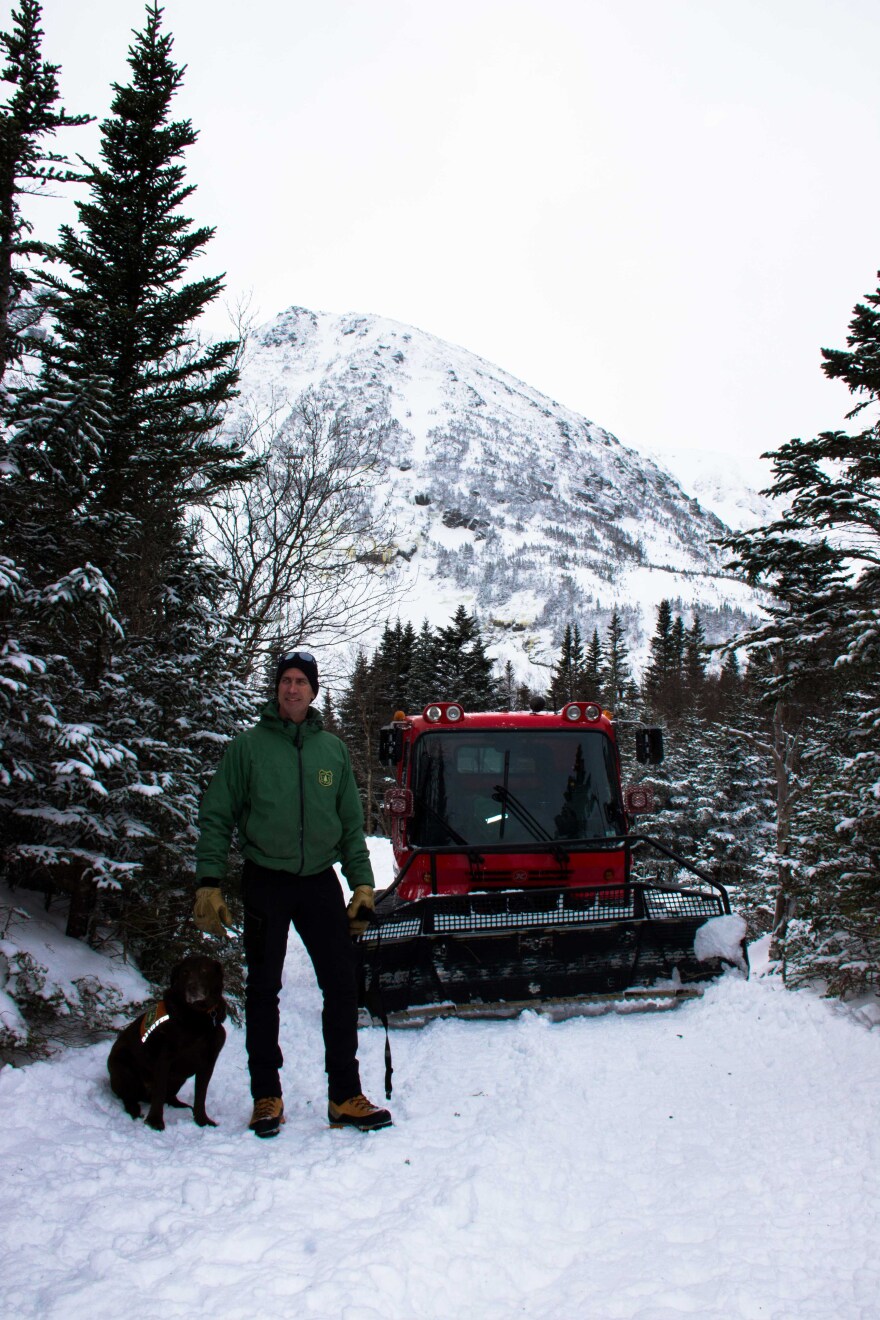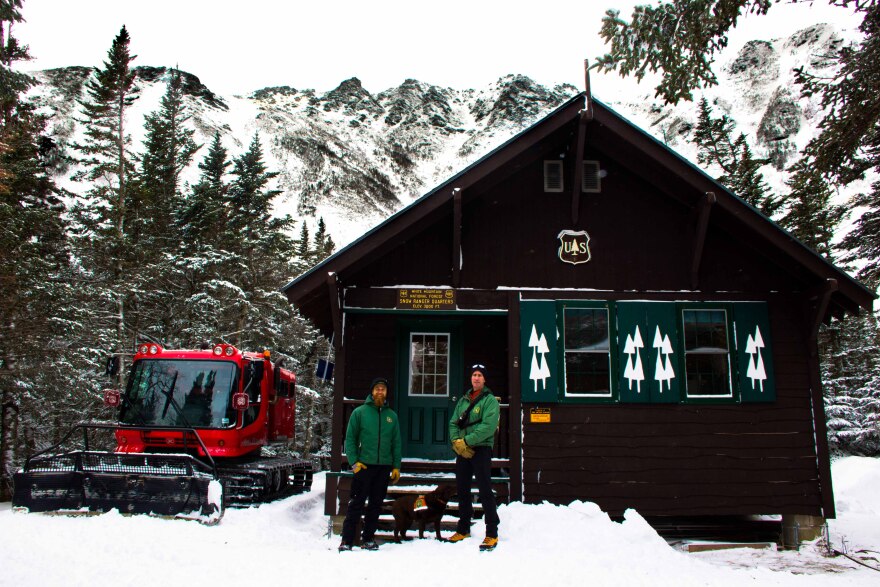With 9 inches of new snow and strong winds expected throughout the day, the Snow Rangers at the Mount Washington Avalanche Center have raised the avalanche threat level to "Considerable" across the Presidential Range and "High" in places like Tuckerman Ravine. "Human-triggered avalanches are likely,” the forecast reads, “and will be large enough to bury and kill a person on open slopes and gullies." As NHPR’s Sean Hurley discovered during a recent visit to Mount Washington, the Snow Rangers don’t mess around - and they don't want you to either.
Once I climb aboard the search and rescue snowcat at the Pinkham Notch parking lot, the Director of the Mountain Washington Avalanche Center, Frank Carus, tells me he finds the Snow Ranger name a little old-fashioned. “Because we're the only Avalanche Center in the east,” Carus tells me, “that Snow Ranger name has stuck for longer.”

Forecaster would probably be a more appropriate title, he says, “but that doesn't address the fact that we do rescues - that's the other weird thing. We're one of only two avalanche centers that also do rescue.”
Our heaving, vibrating, 2-and-a-half mile churn up the Tuckerman Ravine Trail to Hermit Lake will take about 30 minutes.

Lilly the Avalanche Dog runs out in front of us, excitedly sniffing the snow here and there as though a rescue is underway. “A human under the snow gives off a plume that moves through the avalanche debris,” Carus says, “and they can smell it and identify the alert to the person or the article in the snow.”
Avalanche dogs seldom find living people, Carus tells me grimly. After 15 minutes buried in snow, a person’s chance for survival drops to 50 percent - and dogs like Lilly are most often used for body recovery.
As the snowy shark fin of Mount Washington comes into view, Carus slows to assess the half dozen ravines below the peak. Checking these avalanche paths is a daily part of the job. “Signs of avalanche activity,” he notes, “you can see the old crown lines still up high.”

“What’s a crown line?” I ask and he explains: “It's basically the snow that remains after an avalanche slab breaks off. It's like a sharp line in the snow. I think you can see them up there.”
I follow a frost bright line tracing between dark cliffs and frozen waterfalls and then across the draping open bowl of Tuckerman Ravine, which Carus calls the Roman Colosseum. “We get these natural avalanches you know that deposit 8 or 10 feet of avalanche debris across a football field of space in the bowl and it's just unsurvivable,” he says. “And I really just brace myself for something significant happening at some point soon. You know like six, seven, eight, 10 people all buried all at once, killed. It's really very much within the realm of possibility.”
Imagining terrible things, it turns out, is part of the job. On high hazard days, Carus and the three other Snow Rangers will sit together and pitch disaster scenarios. What if this…what if that…?
Since the 1970s there’ve been 15 avalanche-related fatalities here, he tells me, as we head inside the Snow Rangers headquarters – a sturdy log cabin half way up the mountain.
Carus puts a kettle on, but after scrounging the cupboards can only find a single tea bag…and one cup. “Oh it's cracked. Dang!” he says, noting a little leak in the lone cup. “Ah man! It's like living through the Depression!”

We pass the leaky cup back and forth. “Avalanches are just an amazing phenomenon,” he says, “sometimes there is a loud crack like the crack of a whip, you know, and I've seen that before, triggered that before, and you turn and like just see the slope turning into a plate of glass that's breaking and flowing. I have been caught a couple of times.”
In fact, he says, all the Mount Washington Snow Rangers have personal experiences with avalanches. “You see the slope crack around your feet and all of a sudden everything's moving and you're on this slab that's moving and it's hard to stay on your feet. You can do your best but once you're moving you're basically going where the avalanche wants you to go.”
Snow Ranger Helon Hoffer pops his head in the door. He’s just come from Huntington Ravine and says everything there looks fine. “I'm gonna head over to Hillman's to see if I can rut it up a little,” Hoffer tells Carus.
“We're doing the rescue training tomorrow,” Carus explains to me, “so we'll simulate avalanche debris by plowing up the snow and making big piles and just to try and make a realistic training.”
Hillman’s Highway, the long gully where tomorrow’s training will take place, is also the spot where Hoffer triggered an avalanche a few years back. “And I mostly just went for a long sliding fall surrounded by snow,” Hoffer recalls. “I remember spinning around a couple of times. I remember the snow being stuffed down my face.”
“Sometimes people will ask well why are we paying four guys to go forecast avalanches?” Carus says, “like that's just stupid. Why are people even going out there? Well the reality is what else is going on to drive the economy in northern New Hampshire and all these other rural places where national forests exist? Skiing's a big part of it. Snowmobiling's a big part of it.”
Although avalanche fatalities here and across the U.S. have been level for the last few decades, Carus says that’s despite the fact that there are more people than ever moving through the snowy woods and mountains. “Particularly in the last decade,” Carus says, “backcountry skiing has just exploded. So the reality there is that, like, we're doing well. Between avalanche education and avalanche forecasting, you know we think those two things are big contributors to that trend.”

Though today’s avalanche rating is low, two days ago following a storm that dropped a foot of snow, Carus and his team issued an avalanche warning. Which means only one thing. “We know that we'll see avalanches. Yeah,” he says. “If we don't see avalanches and we issued a warning? We screwed up. Like we were wrong. So we haven't done that yet.”
While there’ve been only a handful of incidents in the range this winter, Frank Carus says the risk is constant and daily. If there’s snow on the mountains, the rangers are on the mountains watching it. “We love what we're doing,” Frank Carus says, “and we know that there would be potentially serious consequences if we didn't do what we're doing for the public.”
And if the cracked cup and lone teabag are anything to go by, the Snow Rangers aren’t spending much time in the cabin drinking tea.
Check today's Avalanche Forecast at the Mount Washington Avalanche Center website.







